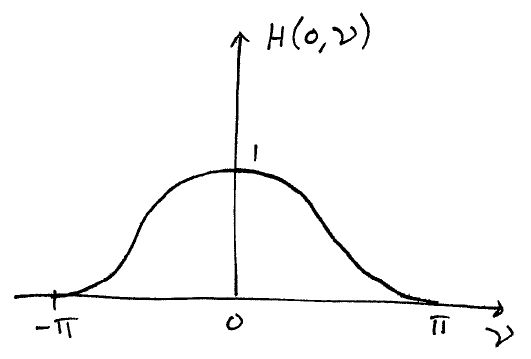Homework 8, ECE438, Fall 2011, Prof. Boutin
Question
a)
$ \begin{align} y[m,n] =& -\frac{1}{8}x[m+1,n-1] + \frac{1}{2}x[m,n-1] - \frac{1}{8}x[m-1,n-1] \\ & -\frac{1}{4}x[m+1,n] + x[m,n] -\frac{1}{4}x[m,n-1] \\ & -\frac{1}{8}x[m+1,n+1] + \frac{1}{2}x[m,n+1] -\frac{1}{8}x[m-1,n+1] \end{align} $
b) Yes. The coefficient matrix of h[m,n] can be written as product of two vectors.
$ \begin{pmatrix} -\frac{1}{8} & \frac{1}{2} & -\frac{1}{8} \\ -\frac{1}{4} & 1 & -\frac{1}{4} \\ -\frac{1}{8} & \frac{1}{2} & -\frac{1}{8} \end{pmatrix} = \begin{pmatrix} \frac{1}{2} \\ 1 \\ \frac{1}{2} \end{pmatrix} \cdot \begin{pmatrix} -\frac{1}{4} & 1 & -\frac{1}{4} \end{pmatrix} $
Therefore the filter can be separate into two 1-D filters.
$ h_1[m] = -\frac{1}{4}\delta[m+1] + \delta[m] -\frac{1}{4}\delta[m-1] $
$ h_2[n] = \frac{1}{2}\delta[n+1] + \delta[n] +\frac{1}{2}\delta[n-1] $
c)
$ H_1(\mu) = DTFT\{h_1[m]\} = -\frac{1}{4}e^{-j\mu(-1)} + e^{-j\mu(0)} -\frac{1}{4}e^{-j\mu(1)} = 1-\frac{1}{2}cos\mu $
$ H_2(\nu) = DTFT\{h_2[n]\} = \frac{1}{2}e^{-j\nu(-1)} + e^{-j\nu(0)} +\frac{1}{2}e^{-j\nu(1)} = 1+cos\nu $
Using the separability,
$ H(\mu, \nu) = DSFT\{ h[m,n]\} = H_1(\mu)*H_2(\nu) = (1-\frac{1}{2}cos\mu)(1+cos\nu) $
$ H(\mu, 0) = 2(1-\frac{1}{2}cos\mu) $
$ H(0, \nu) = 2(1+cos\nu) $
Back to Homework 8
Back to ECE 438 Fall 2011



